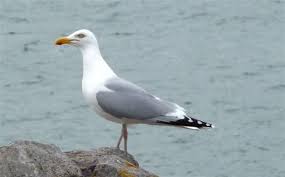There are many seagulls, but few recipes. They range from delicacy to disgusting. Make your own choice:
Gull Recipe by Jan Wolkers:
Bring to the boil a seagull with a brick.
If the brick is cooked then throw the gull away.
Or something more elaborate:
 Dispose of a seagull feathers, beak, feet and entrails.
Dispose of a seagull feathers, beak, feet and entrails.
Let them soak for 12 hours in seawater.
Discard the water. Repeat 3 times.
Season the seagull with a handful of sea salt, bay leaf, mint, basil, etc.
Let the gull 3 hours simmering in a broth with fresh herbs.
Throw the pan overboard because you’ll never get rid of the dirty seagulls taste.
Throw subsequently overboard the gull.
Or, more seriously:
Skin and paunch the seagull as another bird.
Have them infuse a few hours in vinegar water or buttermilk to remove undesirable flavors.
And then prepare as you want them, as other poultry.
Traditional recipe from Finmark Nils Harald Moe
Debone and cut the meat (preferably from the breast) into small pieces.
Fry bacon until the fat has melted. Add the meat, brown it.
Add onion and fry glassy. Add curry and flour along with salt and pepper and whole milk. Let it simmer for 20 minutes. Finish with some cream.
People on forums say that they have eaten seagull in the Hunger Winter of World War II, calling it inedible and dirty. There is no meat on and the fat almost tastes like (whale) tear.
But it was eaten, and it was also used for soup.
In older English writings it is staged as a delicacy. But then it's mostly about seagulls that were captured and then fed a time with grain. This was supposed to benefit the taste.
‘These handsome birds are no longer eaten, but there was a time when, in England, gulls were netted and fattened during winter months in the poultry yard, which may have been sufficient to make them loose their fishiness.’
‘Totnes (England) has a secret legacy of sea bird dishes. Over the centuries, this secluded area of South Devon has come up with a number of ways of cooking the herring gull (Larus argentatus). Despite the unfashionable idea of eating sea gulls, the thrill of eating one of the many superb delicacies on offer still tempts the seabird connoisseur. Traditional dishes such as gull pie, marinated gull and mint, smoked gull souffle and roast gull have been extended by inventive offerings such as chillied gull with ginger, gull veronique and gull mousse through to the offbeat "lashings of larus". However, despite its bulky size, the gull is largely composed of feathers. One gull doesn't go very far. It is not a chicken - or a turkey. Serious gull cuisine needs considerable numbers of birds with which to prepare the dish.’
http://www.totnes-bsac.co.uk/misc/gulls.html
Gulls Eggs are apparently valued higher (than the meat) in several coastal regions.
Gulls eggs tastes fishy. You should never use them raw because they may contain traces of paratyphoid or salmonella.
Gull eggs were picked on Texel until the 19th century.
